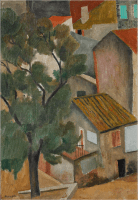Nina Hamnett was a powerful proponent of the British avant-garde and throughout her early career was one of the most respected artists on the London art scene, championed by modern giants such as Walter Sickert and Roger Fry. Brimming with energy and colour, this landscape of interlocking rooftops recapitulates the vitality of the modernist movement in Britain, of which Hamnett was at the epicentre.
Hamnett’s studio was based in a thriving artistic community, just around the corner from Walter Sickert and Roger Fry’s respective studios on Fitzroy Street, London. She set up her studio at 41 Grafton Street in 1911, the year between Roger Fry’s two ground-breaking exhibitions of Post-Impressionist art (1910 and 1912) held at the Grafton Galleries. The impact of these exhibitions on British sensibility cannot be overstated, and Hamnett was a stone’s throw from its source. The powerful brushstrokes of this landscape attest to the new perspective of pioneering painters at this time.
The canvas depicts...
Nina Hamnett was a powerful proponent of the British avant-garde and throughout her early career was one of the most respected artists on the London art scene, championed by modern giants such as Walter Sickert and Roger Fry. Brimming with energy and colour, this landscape of interlocking rooftops recapitulates the vitality of the modernist movement in Britain, of which Hamnett was at the epicentre.
Hamnett’s studio was based in a thriving artistic community, just around the corner from Walter Sickert and Roger Fry’s respective studios on Fitzroy Street, London. She set up her studio at 41 Grafton Street in 1911, the year between Roger Fry’s two ground-breaking exhibitions of Post-Impressionist art (1910 and 1912) held at the Grafton Galleries. The impact of these exhibitions on British sensibility cannot be overstated, and Hamnett was a stone’s throw from its source. The powerful brushstrokes of this landscape attest to the new perspective of pioneering painters at this time.
The canvas depicts a patchwork of colour-blocked rooftops foregrounded by a tall tree, built up in daring layers of paint applied in truncated brush strokes. Within this painting, Hamnett fuses a multitude of modernist theories; the patches of parallel strokes (painted wet into wet) which form the tree are reminiscent of Paul Cezanne’s later technique whilst the mélange of interlocking shapes that govern the buildings in the background harks to the emphasis on design advocated at the Omega Workshop.
This transnational approach to painting is reflective of Hamnett’s lifestyle more generally. As Alicia Foster astutely notes, ‘For Hamnett, freedom in art and life meant movement, from London to Paris and beyond, through the streets, studios, galleries, book shops and cafes.’[1] As such, this urban landscape stands as a self-portrait of Hamnett’s freedom as a modern woman. Hamnett eschewed traditional ‘feminine’ roles with aplomb and, as a result, her vivacious personality – she was known as ‘The Queen of Bohemia’ - overshadowed her talent as a painter. This was partially aided by the success of her two autobiographies Laughing Torso and is She a Lady? which record her continual refusal to be constrained by the limitations expected of an early twentieth-century woman. Writing in 1918 (the same year that he wrote the catalogue introduction to her first solo exhibition) Walter Sickert revealed;
Nina Hamnett has shown at every stage of her rapid and somewhat turbulent development as a draughtsman and painter the possession of unmistakable power. An imperious instinct in the choice of her influences, a generous and frank surrender to such influences, and an almost indecent gluttony for work have placed her in a position that is, for an artist of her age, sufficiently brilliant…[2]
Indeed, the brilliance of this landscape is a testament to Hamnett’s early oeuvre. Through this work, Hamnett reimagines the possibilities of the landscape genre. The traditional fixed viewpoint which prioritised a receding skyline has been discarded in favour of a multi-perspectival approach, in which no skyline is visible at all. Instead, Hamnett creates a sense of depth through the crystallisation of the leaves juxtaposed with the heavy flat rooftops in the background. Her forthright and imaginative approach to painting, combined with her dashing disregard for gender constrictions, positions her as one of the most remarkable artists of the early twentieth century.
[1] Alicia Foster, (2021). ‘Nina Hamnett then and now’ in Nina Hamnett, Lisa Brice, East Sussex: Charleston Press, p. 22.
[2] Walter Sickert, ‘Nina Hamnett’, Cambridge Magazine, 8 June 1918, in Anna Gruetzner Robins (ed.), (2000) Walter Sickert: The Complete Writings on Art, Oxford and New York, p.424.













